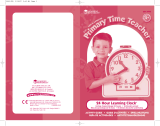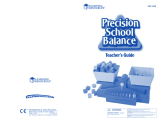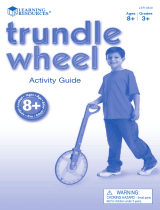Page is loading ...

Activity Guide
The Math Balance is a great tool for visualizing simple mathematical equations and
number relationships. When a weight is placed on a number peg (i.e. 6) on the balance, the
weight appears to take on the numerical value of that peg and causes the balance to tilt.
In order to level the balance, a weight must be placed on the opposite side of the balance
arm, either on the equivalent peg (6) or two or more different pegs that equal the same
number (i.e. 5+1).
Suggested Activities:
ORDERED PAIRS
Find all the ordered pairs for a number by combining two weights to balance the
opposite weight. For example, place a weight on the 10. To balance, place a weight on the
9 and on the 1 (9,1) and then on the 8 and on the 2 (8,2). Continue until all ordered pairs
have been found. Find all the ordered pairs for several different numbers.
EQUATIONS
Create addition,
subtraction,
multiplication and
division equations using
LER 0100
ADVERTENCIA:
Peligro de asfixia – Piezas pequeñas. No se recomienda para niños menores de 3 años.
ATTENTION: Risque d’étouffement. Ne convient pas aux enfants de moins de 3 ans. Présence
de petits éléments susceptibles d’être ingérés.
VORSICHT: Erstickungsgefahr – Kleine Teile. Ungeeignet für Kinder unter 3 Jahren
ATTENZIONE:
Rischio di soffocamento – Contiene pezzi piccoli. Non adatto ai bambini di età inferiore ai 3 anni.
ATENÇÃO:
Perigo de sufocamento – Peças pequenas. Não recomendável para crianças menores de 3 anos.
WAARSCHUWING: Niet geschikt voor kinderen onder de 3 jaar
!
WARNING:
CHOKING HAZARD - Small parts.
Not for children under 3 years.

the balance. Have the students discover the unknown variable or answer by experimenting
with the placement of different weights in order to balance the arm.
Examples:
• ? + 4 = 7 (1 weight on the number 4 peg on the left side of the balance, 1 weight on
the number 7 peg on the right side of the balance, students should add 1 weight to
the 3 peg on the left side to balance.)
• 6 x 4 = ? (4 weights on the number 6 peg on the left side of the balance, 2 weights
on the 10 peg and 1 weight on the 4 peg on the right side of the balance.)
• 24 divided by 6 = ? (start with 2 weight on the number 10 peg and 1 weight on the
number 4 peg on the left side, place one weight on the 6 peg on the right side. Add 3
more weights onto the 6 peg to balance.)
FRACTIONS, DECIMALS, and MORE
Use the provided adhesive labels included to create different values on the other side of
the balance, for example: 2
1
/
2
, 2
1
/
4
, 2, 1
3
/
4
, 1
1
/
2
, 1
1
/
4
, 1,
3
/
4
,
1
/
2
,
1
/
4
=
1
/
4
,
1
/
2
,
3
/
4
, 1, etc.
The labels can easily be removed to explore various math skills, such as, fractions,
decimals, weight values, and money values.
__________________________________________
La Balanza Matemática es una herramienta excepcional para visualizar ecuaciones
matemáticas sencillas y relaciones numéricas. Cuando se coloca el peso en un gancho
numérico de la balanza (por ej. 6) entonces parece como si se asignara el valor numérico
del gancho al peso y esto hace que se incline la balanza. Para poder equilibrar la balanza,

• 6 x 4 = ? (4 pesos no taco 6 do lado esquerdo da balança e 2 pesos no taco 10 e 1 peso
no taco 4 do lado direito da balança).
• 24 dividido por 6 = ? (comece com 2 pesos no taco 10 e 1 peso no taco 4 do lado
esquerdo, coloque um peso no taco 6 do lado direito. Acrescente mais 3 pesos no taco
6 para equilibrar a balança).
FRACÇÕES, DECIMAIS e MAIS
Use as etiquetas colantes fornecidas para criar diferentes valores do outro lado da
balança, por exemplo: 2
1
/
2
, 2
1
/
4
, 2, 1
3
/
4
, 1
1
/
2
, 1
1
/
4
, 1,
3
/
4
,
1
/
2
,
1
/
4
=
1
/
4
,
1
/
2
,
3
/
4
, 1, etc. As
etiquetas podem ser facilmente removidas para poder explorar várias noções de
matemática, como fracções, valores decimais, pesos e valores monetários.
© Learning Resources, Inc., Vernon Hills, IL (U.S.A.)
Learning Resources Ltd., King’s Lynn, Norfolk (U.K.)
Please retain our address for future reference.
Made in Taiwan. LRM0100-GUD
For a dealer near you, call:
(847) 573-8400 (U.S. & Int’l)
(800) 222-3909 (U.S. & Canada)
+44 (0)1553 762276 (U.K. & Europe)
Find more quality products
at our Web site:
/










